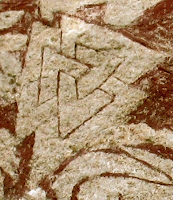The Silver Bough will soon be introducing three new lines of handmade designed items to our shop.
Valknut Sculptures: these beautifully crafted small 3D oak sculptures will be mounted on a polished Black Walnut base. For shipping purposes and convenience to our customers, the sculptures will be mounted on the base by a thin copper ‘stand’ which is detachable from the base. All Valknuts are hand made and finished.
Wooden Hanging Runes: Each rune is made to order. Again these runes are fashioned in oak and handcrafted. A brass fixing at the top with a suede leather thong will allow you to hang these where you feel appropriate. Each choice of rune is unique to the buyer.
Handcrafted Cards: Yggdrasil and Runic cards. Each card is individually handcrafted. There will be differences between each due to the uniqueness and handmade nature of each Yggdrasil (Life Ash – Norse Tree of life, which encompasses the Nine Worlds) and runic cards. Each card will be supplied with an envelope and a plastic sleeve to protect them. They will be sold individually (free P&P) or in boxed groups of ten.
Commissions considered on any other design which you might require. This does not exclude non-Norse or non-Celtic designs.










